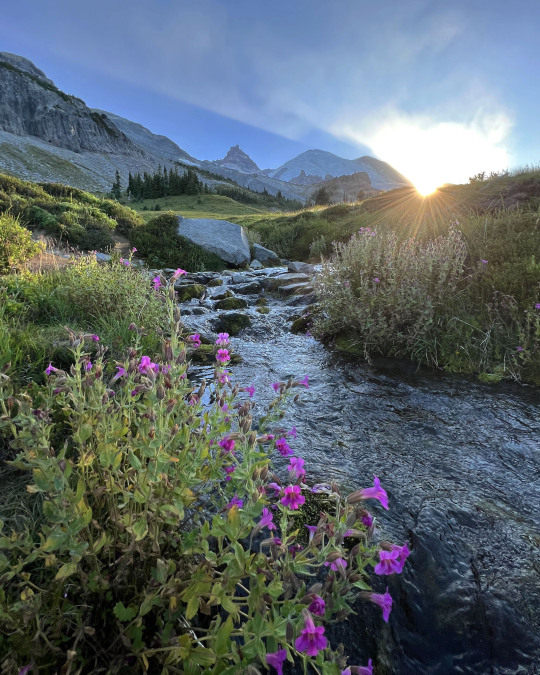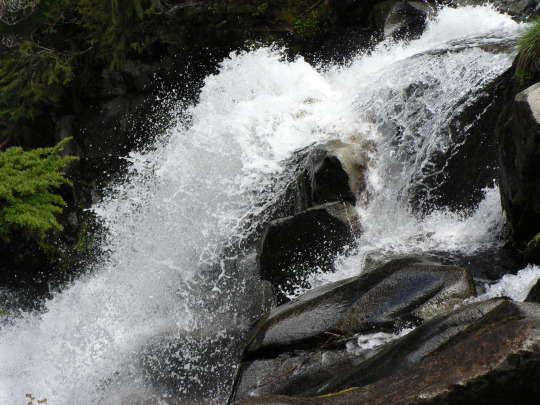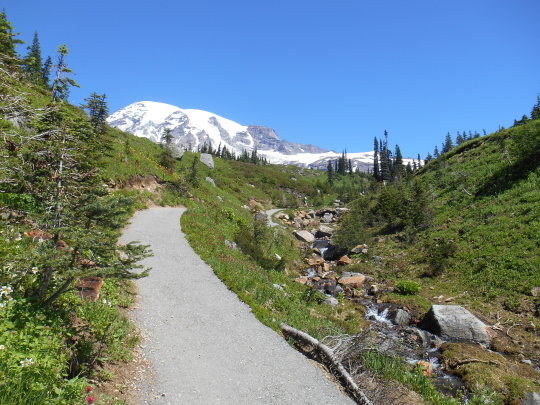#Lewis' monkeyflower
Explore tagged Tumblr posts
Text

The sun is setting on #RainierWildflowers for the season, but fall color is on its way. Some late-blooming flowers like pearly everlasting, Cascade asters, and fireweed can be found in the Paradise area, while very few remain at Sunrise. However, Summerland and Berkeley Park on the east side of the park still have some blooms, like Lewis’ monkeyflower.
As always, remember to please stay on trail! It doesn’t take many steps to trample the wildflowers you are coming to see. Many trails offer great opportunities for that perfect mountain + wildflower photo. Where are you finding wildflowers?
For updates on what’s blooming where visit https://go.nps.gov/RainierWildflower
Unfamiliar with Mount Rainier’s wildflower species? Check out the wildflower guide at https://go.nps.gov/RainierWildflowerGuide
NPS/A. Wotton Photo of Lewis' Monkeyflower at Summerland with sun setting behind Mount Rainier, 8/18/23.
#Rainier Wildflowers#mount rainier national park#wildflowers#Summerland#Lewis' monkeyflower#monkeyflower
62 notes
·
View notes
Text
White flowers: Anaphalis margaritacea / Pearly Everlasting
Pink flower: Erythranthe lewisii / Lewis' Monkeyflower



The closer you look, the more interesting nature is 🌸🔎
#Anaphalis margaritacea#Erythranthe lewisii#Pearly everlasting#Western pearly everlasting#Lewis' Monkeyflower#Great purple Monkeyflower#Monkeyflower#Wildflowers#Plants#Flowers#plantblr#plant identification#Taxonomy
75 notes
·
View notes
Text

Lewis's Monkeyflower (Mimulus lewisii) showing off : )
(c) riverwindphotography, July 2023
283 notes
·
View notes
Text




Hebrides 2010 (2) (3) (4) by James Laing
Via Flickr:
(1) Memorial cairn to the Grias and Coll raiders, north of Stornoway. Overlooks a fantastically noisy group of nesting arctic terns. (2) Tolsta beach Isle of Lewis. (3) (4) Machair, mostly blotched monkey flower.
3 notes
·
View notes
Photo

Glacier National Park: Lewis’ Monkeyflower
Sometimes I wonder if I’d be in such a rush to get macro shots of all these gorgeous flowers if I knew what they were called and therefore what I’d have to caption them on my blog a month after seeing them.
#oh well here we are#wildflowers#flowers#glacier national park#lewis' monkeyflower#my photo#made by me#montana 2018
22 notes
·
View notes
Text


#purple monkeyflower#lewis's monkeyflower#mimulus#erythranthe lewisii#crimson columbine#aquilegia formosa#california native plants#van nuys
4 notes
·
View notes
Text









Flowers flowers flowers flowers
#nature#utah#mountains#hiking#landscape#flower#flowers#wildflowers#buckwheat#sego lily#mint#field mint#mules ears#alpine paintbrush#shooting stars#fireweed#tansy#parry’s primrose#lewis monkeyflower#monkeyflower
38 notes
·
View notes
Photo

Erythranthe lewisii, Lewis’s monkeyflower (formerly Mimulus lewisii), at Mt. Baker in Washington State. These pretty summer subalpine wildflowers are favorites of bumblebees!
#lewis's monkeyflower#erythrane lewisii#mimulus lewisii#monkeyflower#wildflowers#monkey flower#mount baker#mt. baker#plants of washington state
23 notes
·
View notes
Text

Lewis’ Monkeyflower - High Uintas - July 2020
#utah#mountains#backpacking#wild flowers#high uintas#hiking#adventure#camping#ashley national forest
1 note
·
View note
Video
From the archives Via Flickr: Great Purple Monkeyflowers (Mimulus lewisii)
0 notes
Photo


Sweep Lewis Monkey Flower
These flowers are characterized by their mouth-like shape, a “throat” that flares into two upper and three lower petals.
Prefers rich, moist, loamy soil and Full Sun...
#greenchats #flowers #nature #flower #love #photography #naturephotography #flowerstagram #garden #photooftheday #flowersofinstagram #plants #instagood #flowerphotography #macro #naturelovers #instagram #photo #flores #green #beauty #roses #gardening #flowerpower #sweepmonkeyflower #monkeyflower
1 note
·
View note
Text
Creeks. In the summer, creeks are great little riparian areas to see water loving plants (Lewis monkeyflower, etc.) and water loving animals (American dipper to name one).

In Spring, creeks can be a bit more dangerous. One risk is that the deep snow pack builds snow bridges over the higher elevation creeks. As the snow melts, these snow bridges get thinner and thinner. Supporting less and less weight until something falls through. Please, don’t let that something be you.
While it’s great to spend these longer spring days out exploring, it’s important to know where a hidden creek may be lurking under a fragile snow bridge. Either using a paper or digital map, or GPS (make sure to have extra batteries), you can figure out where hidden creeks may be skulking and avoid these dangerous traps.
Creeks look happy, cheerful and benign in the summer but these hidden creeks can be running bank-full of just above freezing water. A fall could be a quick, freezing dip, or it could be far, far worse.
Play it safe and have a great adventure. Use your maps or GPS so you can have a wonderful time in your national park.
Which do you prefer paper maps or digital? Do you prefer a GPS over a plain map?

Park information on winter safety can be found here https://www.nps.gov/mora/planyourvisit/winter-safety.htm Information on the 10 Essentials can be found on this website https://www.nps.gov/articles/10essentials.htm Northwest Avalanche Center is at Home - Northwest Avalanche Center (nwac.us)
These photos are from years past and do not reflect current conditions. NPS/S. Redman photo. Waters of Paradise River cascade over rocks. June 2005. NPS photo. Looking up paved asphalt of Dead Horse Creek trail towards Mount Rainier. Dead Horse Creek waters run down over rocks beside the trail. May 2015.
28 notes
·
View notes
Text

A cluster of White geranium, Lewis' monkeyflower and Indian paintbrush
(c) riverwindphotography, July 2024
785 notes
·
View notes
Text

Lewis' Monkeyflower nods over a little streamlet
(c) riverwindphotography, July 2024
506 notes
·
View notes
Photo

Lewis’ Monkeyflower (Mimulus lewisii) blooms along a clear mountain stream, Yellowstone National Park, Wyoming
(c) riverwindphotography, July 2020
253 notes
·
View notes
Photo



Lewis’ Monkeyflower and Purple Aster are now in full bloom at higher elevations in Yellowstone: (c) riverwindphotography, August 2020
434 notes
·
View notes
